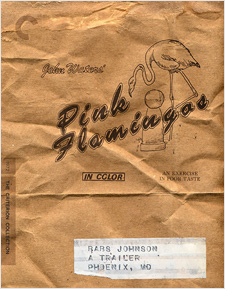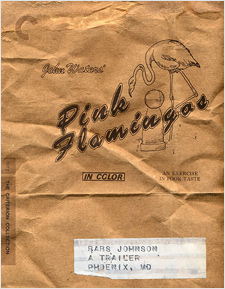Pink Flamingos (Blu-ray Review)

Director
John WatersRelease Date(s)
1972 (June 28, 2022)Studio(s)
Dreamland/New Line Cinema/Warner Bros (Criterion Collection – Spine #1131)- Film/Program Grade: B
- Video Grade: B
- Audio Grade: B
- Extras Grade: A
Review
Pink Flamingos is a film that savors its own bad taste, vileness, stomach-turning scenes, and reprehensible characters. It’s the antithesis of what audiences have come to expect of movies, and that’s what has made it the most unlikely of classics.
Divine, a 300-pound man in drag, is Babs, a flamboyant lady who lives with her friend Cotton (Mary Vivian Pearce), her delinquent son, Crackers (Danny Mills), and her mentally-challenged mother (Edith Massey). Babs prides herself on being the world’s filthiest person. Envious of Babs and determined to claim the title for themselves are Connie Marble (Mink Stole) and her husband, Raymond (David Lochary). These two psychos kidnap young women, impregnate them, and sell the children to lesbian couples in order to finance an inner-city heroin ring that preys on high school students. The plot rests on this cut-throat (and often disgusting) competition.
Watching Pink Flamingos is like attending a freak sideshow. John Waters presents several vignettes intended to astonish, repel, and nauseate, often simultaneously. Babs gets a pig’s head for her birthday and tenderizes steaks between her legs, everyone does drugs, a naked man displays his flexible anus in rhythm to a pop tune, Babs and her friends kill a group of policemen and eat them, genitals are lopped off, and a sex scene adds a live chicken to the mix.
One of the oddest touches is Babs’ mother, a mountainous, simple-minded woman who lives in a crib, devours eggs and nothing else, and drools when the egg man arrives and opens a case to display his wares as if they’re rare jewels. No mention is made as to why she’s in the crib, which makes the scenes all the more bizarre. Her family simply sits by the crib, engages her in mundane conversation, and is totally accepting of her.
With a blonde wig, outrageous make-up, and ample flesh stuffed into a variety of skintight skirts, pants and gowns, Divine’s Babs easily dominates the film with her foul mouth, delight in her own vileness, and willingness—however immoral, illegal, or unsanitary—to hold on to her cherished title.
The acting is strictly amateur, with stilted line readings, awkward pauses, unsure gestures, and dialogue delivered at peak volume at all times. Though this adds to the overall strangeness of the film, it wears thin pretty quickly. Compared to his fellow cast members, Divine turns in an Academy Award performance, but let’s remember, everything is relative.
John Waters overwrote his script to the point that nearly every scene is composed of long unrelieved stretches of dialogue, with no movement. The camera is stationary while the actors recite scenes that go on for 2 to 3 minutes, never switching to close-ups or alternate angles for variety or emphasis. This makes for tedious viewing. Waters gets away with this non-cinematic approach because of the over-the-top dialogue and actors’ enthusiastic, if unconvincing, delivery. It’s as if we’re seeing an early rehearsal of a script that needs many revisions.
Pink Flamingos gained its dubious reputation in the early 1970s when it made the rounds of the midnight circuit. Its intentional avoidance of cinematic tradition, unorthodox content, offbeat characters, poor production value, irreverence, and sheer excess showed that movies didn’t have to follow precedents or subscribe to traditional structure. Waters never treads lightly on gross content, and revels in presenting it in all its glorious outlandishness. He creates a sordid world in which vice and depravity are a daily way of life. The final scene, which earned the film much of its notoriety, was shot in a single, uninterrupted take. It’s the ultimate example of stomach-turning excess and probably one of the most famous scenes in American cinema.
Pink Flamingos was shot by John Waters himself with an Auricon 16 mm camera, finished photochemically, and printed in the negative aspect ratio of 1.37:1. It was then blown up to the aspect ratio of 1.85:1 for its 35 mm theatrical release. The Criterion Collection Blu-ray release features a 1.66:1 aspect ratio. According to Criterion, “Unlike original elements for some of Waters’ other early films... the 16-millimeter Ektachrome positive scanned for this release was kept in his attic for the past five decades, and it is the same film that Waters originally hot-spliced and edited to make the movie. It was scanned at 4K resolution on a Lasergraphics Director film scanner.” Though the film looks better than earlier home video releases, it still reflects its low-budget genesis. Lighting is flat, with little attempt to create atmospheric shadows. There’s little depth to interiors and actors are photographed unattractively which, judging by the story, may have been intentional. Divine’s make-up is clown-like and his costumes garish and purposely ill-fitting. Actual locations rather than sets are used, enabling Waters’ small 16 mm camera to shoot in tight spaces, like the trailer interior.
The soundtrack is English mono LPCM. English SDH subtitles are an available option. There’s a slight echo-y quality throughout. Dialogue is clear, though most actors speak at a shouting level, allowing for little vocal variation. This constant verbal onslaught from the entire cast seems a desperate way to compensate for amateurish line delivery. Divine bellows, rather than speaks, as if in a constant state of anger. Mink Stole and David Lochary have long, unrelieved scenes which showcase their shortcomings as actors. Waters devotes a lot of footage to a trailer fire, its crackling prominent. Incidental scenes feature weird instrumental music that underscores the atypical tone of the film.
Bonus materials on the director-approved Criterion Collection Blu-ray release include the following:
- Two Audio Commentaries with John Waters
- Divine Trash (97:18)
- John Waters and Jim Jarmusch (30:20)
- Tour of the Film’s Baltimore Locations (22:24)
- 25th Anniversary Footage (13:32)
- Outtakes (25:38)
- Trailer (2:08)
Audio Commentaries – Commentary #1 was recorded in 1997 for The Criterion Collection LaserDisc release and Commentary #2 was recorded in 2001 for the New Line Cinema DVD release. Waters notes that the opening credits are so long because every single person in the film, including extras, is listed. The cast includes “everyone I knew” and their friends. Waters himself narrates, imitating the voice of Baltimore radio personality Mr. Ray (who adamantly refused to be a part of the film). Waters takes us through the making of Pink Flamingos, noting that he was inspired to make it by a scene in Multiple Maniacs. Other inspirations included the Manson family murders, the Weathermen, films by other directors, anti-political correctness, and political figures who were in hiding. His parents looked down on people who lived in trailers. Waters used odd instrumental music that suggested trailer living. Mink Stole was usually cast as Divine’s nemesis in Waters’ films. He goes into detail about the awful conditions making the film—18-hour shooting days, freezing weather, bad food. He provides an update on cast members and what they’re doing today. Divine, aka Harris Glen Milstead, died in 1988 at the age of 42 from complications of obesity. With its ambitious shooting schedule, the film took only ten days to film. It was shot in sequence in and around Baltimore. Waters speaks lovingly and nostalgically of the film that propelled his career into mainstream movie making.
Divine Trash – This feature-length documentary was made by Steve Yaeger in 1998. The Criterion Collection LaserDisc previously included selected scenes from it, but it’s included in its entirety here. It features interviews with director John Waters; Dreamland performers Mink Stole, Mary Vivian Pearce, Divine, David Lochary, Edith Massey, and Vincent Peranio; producer John Pierson; actor Steve Buscemi; filmmakers Jim Jarmusch, Herschell Gordon Lewis, Paul Morrissey, and the Kuchar brothers; and others. The film won the Filmmakers Trophy for Best Documentary at the 1998 Sundance Film Festival.
John Waters and Jim Jarmusch – This new conversation/interview between the filmmakers was recorded in 2022. Waters discusses the first screening of Pink Flamingos in Baltimore in 1972. Jarmusch enumerates the many taboos in the film—incest, murder, cannibalism, castration, dismemberment, involuntary artificial insemination, bestiality. The marketing campaign was built on the film’s negative reviews. Waters never won an obscenity case and eventually pleaded guilty because the fine cost less than the lawyer. Clips from the film are shown. Divine in real life was mild-mannered. “Divine was our Elizabeth Taylor.” Waters cites Andy Warhol as an influence. He discusses the weird instrumentals that are heard throughout, which give the film its distinctive, off-centered tone. Waters speaks of how well the Kodak Ektachrome film used in the making of Pink Flamingos has retained its color over five decades.
Location Baltimore – John Waters visits some of the production’s locations in Baltimore and relates how they were obtained. He also tells behind-the-scenes stories about location filming.
25th Anniversary Footage – This featurette, produced in 1997 for the film’s 25th anniversary, includes a selection outtakes.
Outtakes – More outtakes include a number of scenes that didn’t make it into the film, including a Snow White-inspired Magic Mirror scene in which Mink Stole’s Connie Marble asks an imposing face in her make-up mirror who the filthiest person in the world is. A lot of the footage is scratched or has visible hairs in the film gate. As is typical with outtakes, actors blow their lines.
Trailer – The trailer features moviegoers’ comments after emerging from a showing of Pink Flamingos. They include “Not to be believed,” “Outrageous,” “Fabulous,” and “The grossest film I’ve ever seen.” Quotes from reviews include “From the grotesque to the hilarious,” “Beyond pornography,” and “The sickest movie ever made, and one of the funniest.”
Booklet – This 8-page booklet includes a critical essay by Howard Hampton and a piece by actor/author Cookie Mueller about the making of Pink Flamingos from her 1990 book Walking Through Clear Water in a Pool Painted Black. Also included are black-and-white photos, a list of cast and credits, and information about the digital transfer.
Also included is a reproduction of a “Pink Phlegm-ingo Barf Bag”, which was handed out at screenings of the film during the 1970s.
Pink Flamingos made stars of John Waters and Divine, both of whom went on to make mainstream films, sometimes together, as in Hairspray and Polyester, and sometimes apart. The film was also inducted into the National Film Registry in 2021. Fifty years after its initial release, it still has the power to shock with its mixture of nudity, humor, violence, and satirical depictions of the trailer lifestyle.
- Dennis Seuling

